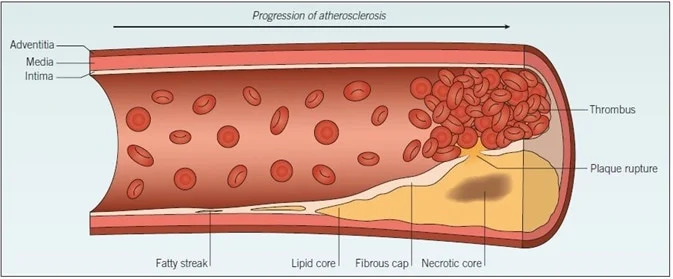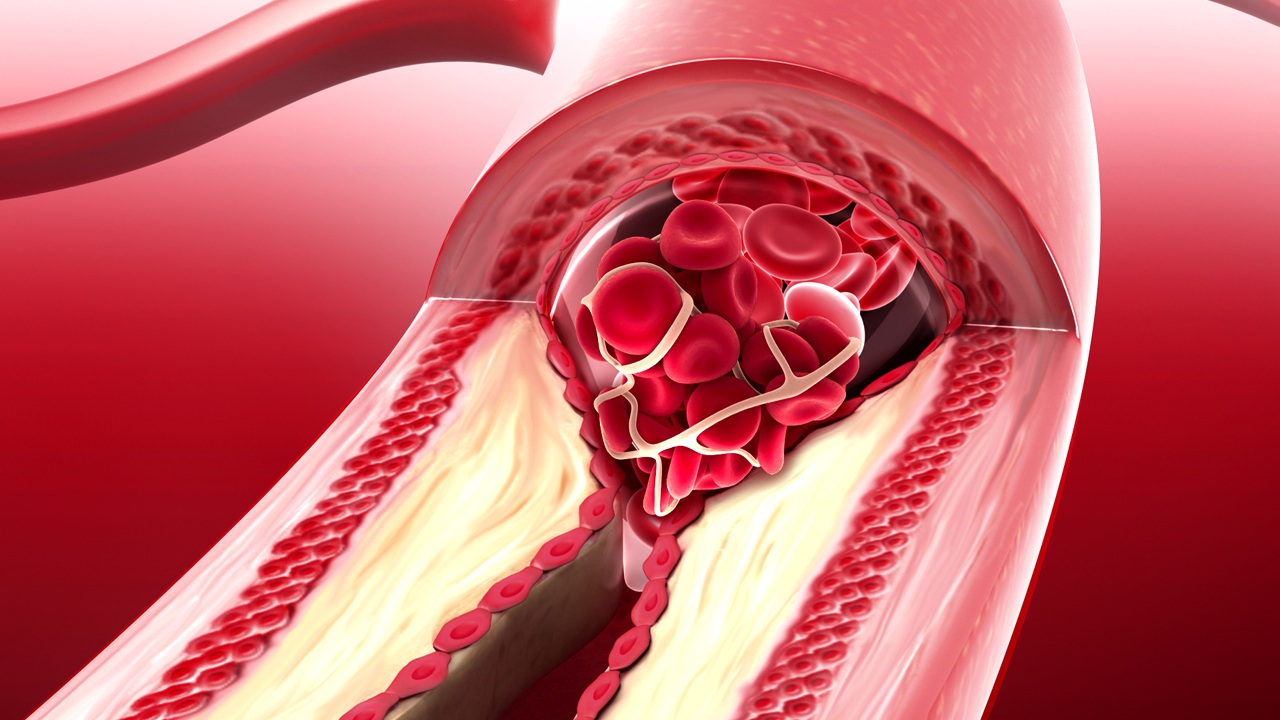What Is Atherosclerosis?
A significant number of Cardiovascular diseases (CVDs) stem from a condition known as atherosclerosis, a chronic disease characterized by the gradual accumulation of arterial plaque (atheroma).
This plaque is composed of fats, cholesterol, calcium, and other substances within the walls of arteries. The process commences with damage to the endothelial lining, followed by an immune response and the growth of plaque. (1,2) As these plaques enlarge, they narrow arterial passages, impeding blood flow and proper tissue oxygenation. (Figure 1)
Furthermore, the persistent blood flow pressure can lead to plaque rupture, resulting in the formation of blood clots (thrombus). These clots can obstruct blood flow, potentially leading to heart attacks, strokes, and other CVDs, which are among the leading global causes of mortality. (1,3)

(Figure 1)
The Silent Killer
Unfortunately, atherosclerosis develops insidiously, often manifesting no symptoms until complications related to CVDs become evident. According to the United States National Institutes of Health, approximately half of individuals aged 45 to 84 have atherosclerosis without their awareness. (1) This underscores the critical importance of atherosclerosis prevention, early diagnosis, and treatment.
What Are the Risk Factors for Atherosclerosis?
Non-Modifiable risk factors
Non-modifiable risk factors include age, gender (male bias), and a family history of CVD’s
Modifiable risk factors
Elevated blood cholesterol and triglyceride levels, hypertension, diabetes, tobacco use, obesity, sedentary lifestyle, and an unhealthy diet high in saturated fats, sodium, and sugars—akin to the Western diet. These lifestyle factors can damage the endothelium, heightening the risk of developing atherosclerosis. (1,5)
Atherosclerosis is a multifactorial disease that initiates with the gradual, progressive damage to the endothelial lining of arteries.
Table 1. Making Lifestyles Changes to Prevent Atherosclerosis (1,6,7)
Scientific evidence indicates that implementing lifestyle changes, as detailed in Table 1, can diminish the risk of atherosclerosis and mitigate its consequences.
Atherosclerosis and Nutrition
Diet plays a pivotal role in preventing atherosclerosis. An imbalanced and unhealthy diet can precipitate conditions such as type 2 diabetes, hypercholesterolemia, hypertension, obesity, and dysbiosis, all of which increase the risk of atherosclerosis.
obesity, and dysbiosis, all of which increase the risk of atherosclerosis. Research has demonstrated that specific nutrients and bioactive compounds, primarily antioxidants, possess the capacity to thwart and decelerate the progression of atherosclerosis owing to their cardioprotective effects.
Among the most extensively studied are omega-3 polyunsaturated fatty acids (PUFAs) and various phytochemicals derived from plants, including polyphenols, phytosterols, lycopene, and dietary fiber. Studies have underscored their potential to reduce inflammation, lower LDL cholesterol levels, and mitigate oxidative stress, all of which are implicated in the progression of atherosclerosis. (6,8)
Foods rich in these bioactive compounds are primarily derived from plants and include nuts, whole grains, legumes, olive oil, tea, fruits, and vegetables. Another recognized source of omega-3 PUFAs is blue fish. (6,8) Furthermore, deficiencies in micronutrients such as magnesium, phosphorus, calcium, and vitamins A, B, D, and E have been linked to an increased risk of atherosclerosis. (6)
Figure 2. Healthy eating pyramid, Spanish Society of Community Nutrition (SENC). (10)
The Mediterranean Diet, An Alternative Preventative Measure.
Research has also highlighted the Mediterranean diet as a potent preventive measure against atherosclerosis and CVDs. This diet is characterized by a high consumption of foods low in refined carbohydrates and saturated fats, while emphasizing vegetables and fruits. (7-9) The Healthy Eating Pyramid, developed by the Spanish Society of Community Nutrition (SENC), serves as an excellent dietary guide based on the Mediterranean diet, aiding individuals in making healthier food choices to enhance their cardiovascular health. (Figure 2) (10)
References
The information published in this Blog article, or in IntelVasc Inc. website, is provided for information purposes only and does not and cannot be considered as a consultation, treatment, therapy, or medical or clinical prescription, nor is it a substitute for treatment, diagnosis, therapy, or supervision by a healthcare professional. The information published is neither intended to be used as a guide and should not serve nor be used as an exclusive orientation for the healthcare professionals to make decisions about the treatment and therapy of their patients, nor does it replace the healthcare professionals’ criteria. IntelVasc Inc. makes no warranties as to the accuracy, suitability, or completeness of the information provided, and shall not be held responsible for any decisions made based on the information provided on this Blog article, IntelVasc Inc. website or any other websites linked or referenced in IntelVasc Inc. website.

